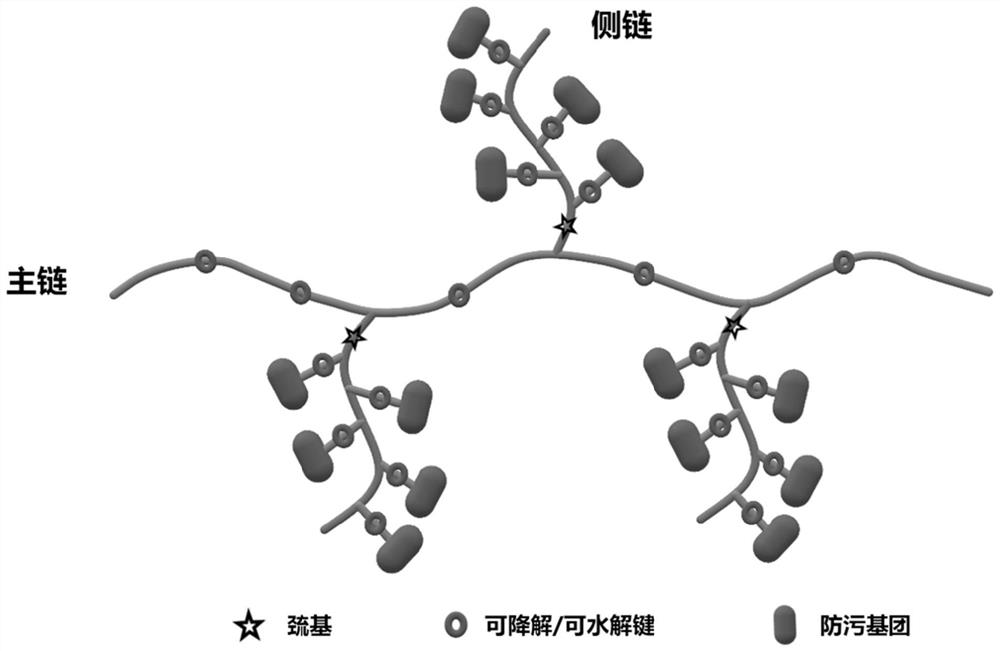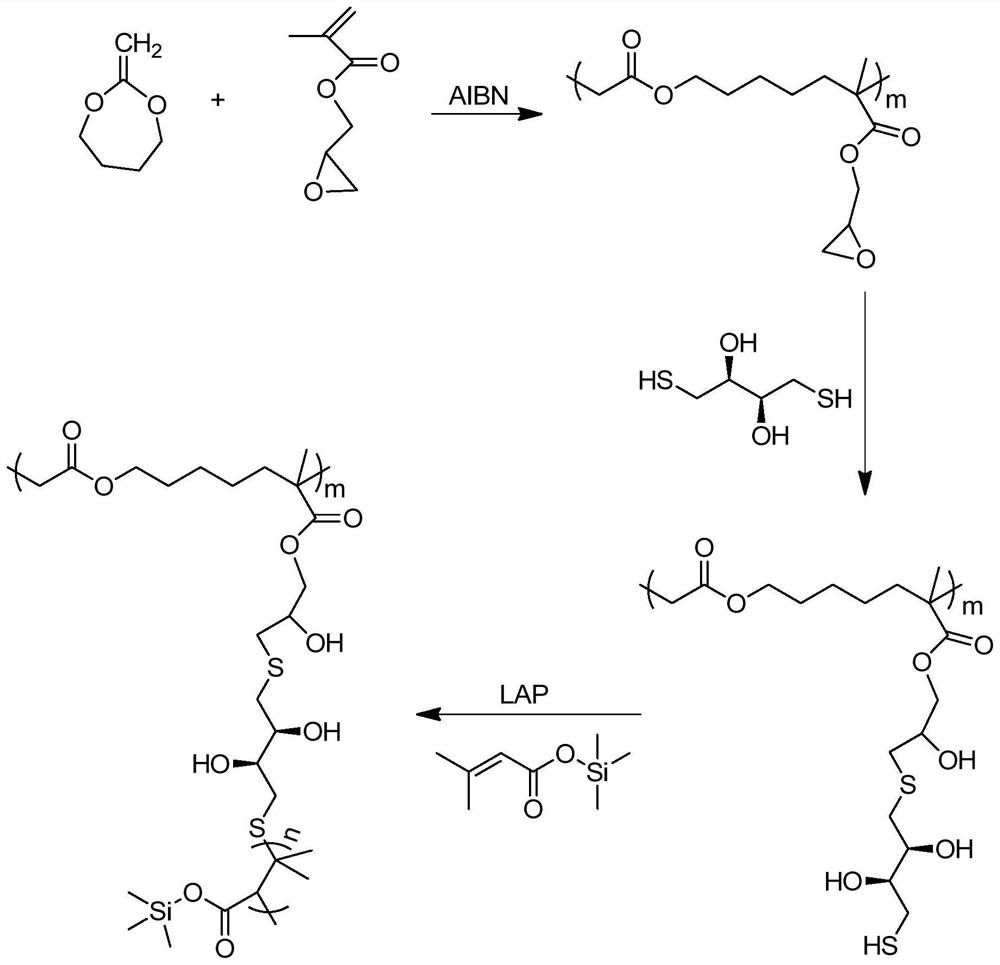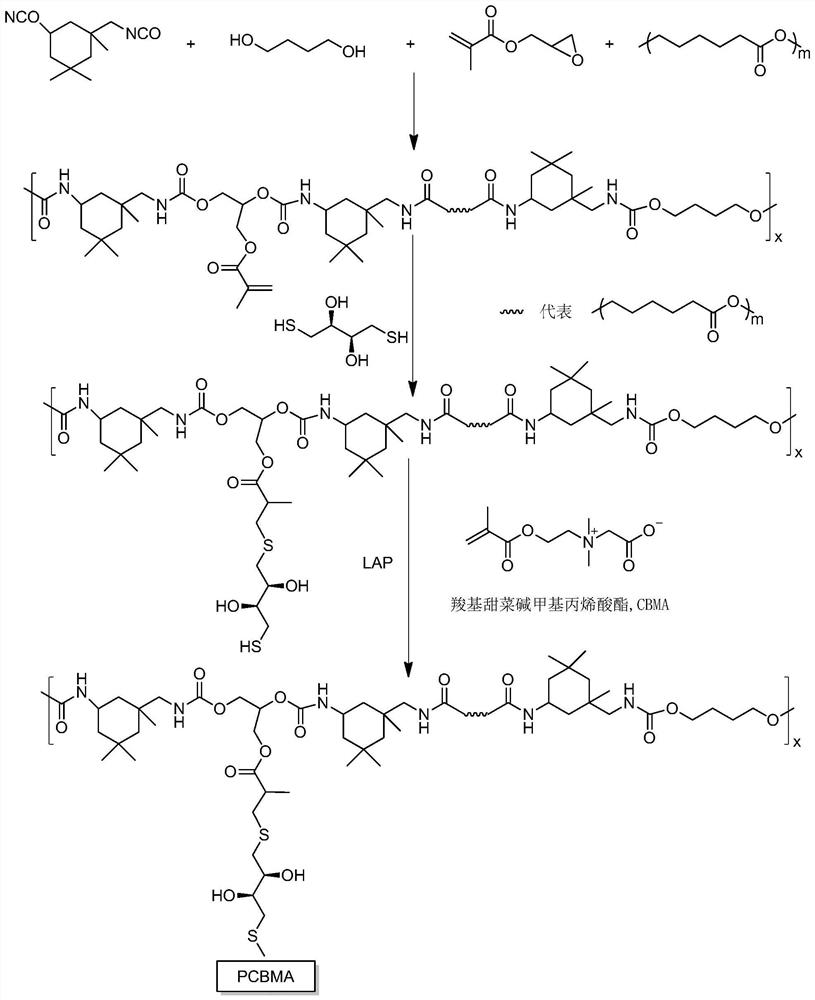Degradable polymer as well as preparation method and application thereof
A technology for degrading polymers and polymers, applied in the field of materials, can solve the problems of low content of antifouling groups, inability to achieve long-term effect and controllable release of antifouling groups, etc., and achieve excellent antibacterial effect and excellent prevention and control of water fouling. effect, the effect of realizing industrial production
- Summary
- Abstract
- Description
- Claims
- Application Information
AI Technical Summary
Problems solved by technology
Method used
Image
Examples
Embodiment 1
[0066] The raw materials for the preparation of the degradable polymer in this example are shown in Table 1.
[0067] Table 1 The raw material composition of the degradable polymer in Example 1
[0068] raw material parts by mass 2-Methylene-1,3-dioxepane 5 Glycidyl methacrylate 6 Azobisisobutyronitrile (AIBN) 0.05 Dithiothreitol 1.15 Trimethylsilyl 3,3-dimethacrylate 15.4 Lithium phenyl-2,4,6-trimethylbenzoylphosphonate (photoinitiator LAP) 0.03
[0069] The preparation steps of the degradable polymer in this example are as follows:
[0070] 1) In a reaction vessel under nitrogen atmosphere, add 5 parts by mass of 2-methylene-1,3-dioxepane, 6 parts by mass of glycidyl methacrylate, 0.05 parts by mass of AIBN and 40 parts by mass of dioxane Methyl chloride was reacted at 70°C for 3 hours to obtain a polymer containing an ethylene oxide group in the side chain;
[0071] 2) In the first step product solution, add 6.5 parts by...
Embodiment 2
[0075] The raw materials for the preparation of the degradable polymer in this example are shown in Table 2.
[0076] The raw material composition of table 2 embodiment 2 degradable polymer
[0077]
[0078]
[0079] The preparation steps of the degradable polymer in this example are as follows:
[0080] 1) In a reaction vessel under nitrogen atmosphere, 5 parts by mass of isophorone diisocyanate, 2 parts by mass of 1,4-butanediol, 4.5 parts by mass of poly(L-lactide-caprolactone), 0.6 parts by mass were added Glycidyl methacrylate and 50 parts of tetrahydrofuran were reacted at 70° C. for 1 hour to obtain the first-step product with an ethylene oxide group in the side chain;
[0081] 2) In the first step reaction solution, add 0.7 parts by mass of dithiothreitol (the molar ratio of dithiothreitol to carboxybetaine methacrylate is 1:15) and react under neutral, 37° C. conditions for 3 hours, the second-step product containing sulfhydryl in the side chain is prepared; ...
Embodiment 3
[0085] The raw materials for the preparation of the degradable polymer in this example are shown in Table 3.
[0086] The raw material composition of table 3 embodiment 3 degradable polymer
[0087] raw material parts by mass Toluene Diisocyanate 5 1,4-Butanediol 2.6 Poly(L-lactide-caprolactone) 4.5 Thioglycerol 0.6 GAMMA-butyrolactone-3-yl methacrylate 10 Lithium phenyl-2,4,6-trimethylbenzoylphosphonate (photoinitiator LAP) 0.03
[0088] The preparation steps of the degradable polymer in this example are as follows:
[0089] 1) In a reaction vessel in a nitrogen atmosphere, 5 parts by mass of toluene diisocyanate, 2.6 parts by mass of 1,4-butanediol, 4.5 parts by mass of poly(L-lactide-caprolactone) (molecular weight 1000), 0.6 parts by mass Parts of thioglycerol and 50 parts of tetrahydrofuran were reacted at 70° C. for 1 hour to obtain the first-step product with a sulfhydryl group in the side chain;
[0090] 2) In the f...
PUM
 Login to View More
Login to View More Abstract
Description
Claims
Application Information
 Login to View More
Login to View More - R&D
- Intellectual Property
- Life Sciences
- Materials
- Tech Scout
- Unparalleled Data Quality
- Higher Quality Content
- 60% Fewer Hallucinations
Browse by: Latest US Patents, China's latest patents, Technical Efficacy Thesaurus, Application Domain, Technology Topic, Popular Technical Reports.
© 2025 PatSnap. All rights reserved.Legal|Privacy policy|Modern Slavery Act Transparency Statement|Sitemap|About US| Contact US: help@patsnap.com



